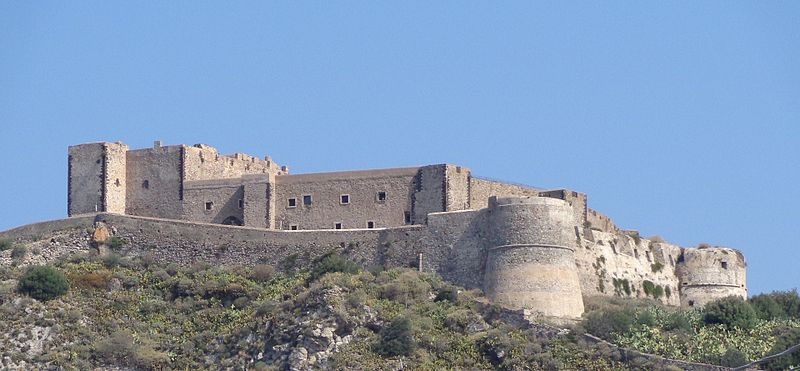
Castello di Milazzo
Il Castello di Milazzo, con una superficie di oltre 7 ettari, di cui 12.070 mq. coperti da fabbricati, svetta sul paesaggio di Milazzo alla sommità dell'antico "Borgo", rappresentando uno dei complessi fortificati più grandi d'Europa.
Lo schema icnografico del complesso è formato da: maschio normanno a pianta quadrata; blocco della domus a pianta rettangolare; cinta sveva rettangolare, con torri sporgenti a pianta quadrata ed edifici che presentano piante rettangolari o trapezoidali allungate; cinta 'aragonese' poligonale, con baluardi emicilindrici, racchiudente il complesso normanno e svevo; ulteriore cinta cinquecentesca con baluardi triangolari verso sud-est.
Il mastio (Torre mastia), chiamata 'torre saracena', l’elemento più antico del complesso, sorge al culmine del castello e si configura come un massiccio blocco parallelepipedo. Presenta due elevazioni (altezza di 14 metri) realizzate in opus incertum, mentre i cantonali spiccano per la vigorosa e regolare tessitura di grossi conci squadrati in scuro materiale vulcanico, plausibilmente importato dalle vicine Eolie.
(English)
Castle of Milazzo
The Castle of Milazzo, with an area of over 7 hectaers ,of wich 12.070 square meters covered by building, stands on the Milazzo landscape at the top of the’ ancient “Borgo” representing one the largest fortified complex in Europe.
The iconographic scheme of the complex consists of Norman keep with a square plan; block of the’’Domus’’ with a rectangular plans, rectangular Swabian wall, with protruding towers with a square plane and buildings with elongated rectangular or trapezidale plans; polygonal Aragonese enclosure with semi-cylindrical bulwarks, enclosing the Norman and Swabian complex; further sixteenth-century walls with triangular bulwarks facing south-east.
The keep (mastia tower)called the ‘’Saracen tower,’’ the oldest element of the complex, stands at the top of the castle and is configured as a massive parallelepiped block.It has two elevations (height of 14 meters) made of opus incertum, while the cantonals stand out for the vigorous and regular texture of large square ashlars in dark volcanic material, plausibly imported from nearby Aeolian Islands